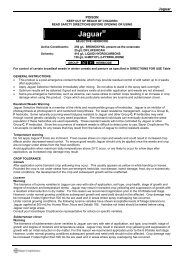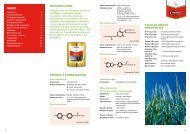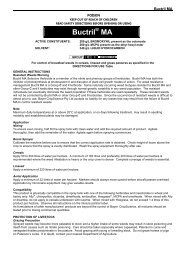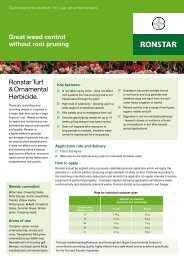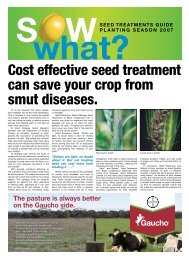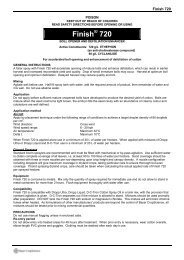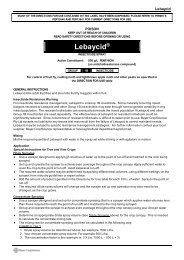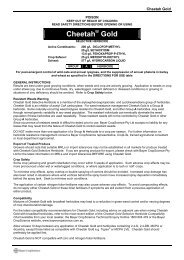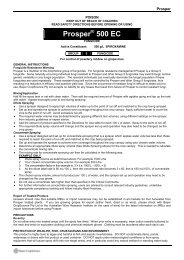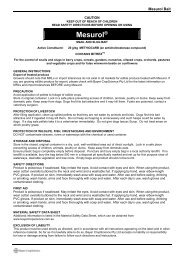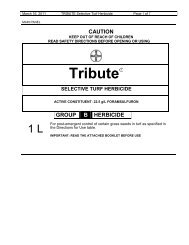Totril® - Bayer CropScience
Totril® - Bayer CropScience
Totril® - Bayer CropScience
You also want an ePaper? Increase the reach of your titles
YUMPU automatically turns print PDFs into web optimized ePapers that Google loves.
POISON<br />
KEEP OUT OF REACH OF CHILDREN<br />
READ SAFETY DIRECTIONS BEFORE OPENING OR USING<br />
Totril ®<br />
SELECTIVE HERBICIDE<br />
Active Constituent: 250 g/L IOXYNIL present as the Octanoate<br />
Solvent: 642 g/L LIQUID HYDROCARBON<br />
GROUP C HERBICIDE<br />
For the control of certain broadleaf weeds in onion crops<br />
Totril<br />
GENERAL INSTRUCTIONS<br />
Resistant Weeds Warning<br />
Totril Selective Herbicide is a member of the nitrile group of herbicides. Totril has the inhibitors of photosynthesis at<br />
photosystem II mode of action. For weed resistance management Totril is a Group C herbicide. Some naturally<br />
occurring weed biotypes resistant to Totril and other Group C Herbicides may exist through normal genetic variability in<br />
any weed population. The resistant individuals can eventually dominate the weed population if these herbicides are<br />
used repeatedly. These resistant weeds will not be controlled by Totril or other Group C herbicides. Since the<br />
occurrence of resistant weeds is difficult to detect prior to use, <strong>Bayer</strong> <strong>CropScience</strong> accepts no liability for any losses that<br />
may result from the failure of Totril to control resistant weeds.<br />
Mixing<br />
To ensure even mixing, half fill the spray tank with clean water, add the required amount of product and stir thoroughly.<br />
Add the remainder of the water and mix again before spraying.<br />
Application<br />
The use of this product should follow standard pre-emergence herbicide treatments or cultivation, otherwise the weeds<br />
are likely to be too large for successful treatment by the time the onions have reached the tolerant stage.<br />
DO NOT apply on a windy day.<br />
DO NOT apply by aircraft or misting machine.<br />
Boom Sprayer<br />
Equip the machine with flat-fan nozzle tips designed to apply 440 or more litres of water per hectare at a pressure of 200<br />
to 280kPa. Calibrate the machine before use to ensure that the correct application rate is obtained. Check the height of<br />
the boom to ensure that the spray is evenly distributed.<br />
Compatibility<br />
As formulations of other manufacturers' products are beyond the control of <strong>Bayer</strong> <strong>CropScience</strong>, all mixtures should be<br />
tested prior to mixing commercial quantities.<br />
PROTECTION OF CROPS, NATIVE AND OTHER NON-TARGET PLANTS<br />
DO NOT apply under weather conditions, or from spraying equipment, that may cause spray to drift onto nearby<br />
susceptible plants/crops, cropping lands or pastures.<br />
PROTECTION OF WILDLIFE, FISH, CRUSTACEANS AND ENVIRONMENT<br />
DO NOT contaminate streams, rivers or waterways with the chemical or used containers<br />
STORAGE AND DISPOSAL<br />
Store in the closed, original container in a dry, cool, well-ventilated area, out of direct sunlight. Protect from extreme<br />
heat and cold.<br />
Triple or preferably pressure rinse containers before disposal. Add rinsings to spray tank. Do not dispose of undiluted<br />
chemicals on site. If recycling, replace cap and return clean containers to recyler or designated collection point. If not<br />
recycling, break, crush, or puncture and bury empty containers in a local authority landfill. If no landfill is available, bury<br />
the containers below 500 mm in a disposal pit specifically marked and set up for this purpose clear of waterways,<br />
desirable vegetation and tree roots. Empty containers and product should not be burnt.<br />
SAFETY DIRECTIONS<br />
Poisonous if swallowed. May irritate the eyes. Avoid contact with eyes and skin. Do not inhale spray mist. When<br />
preparing spray wear cotton overalls buttoned to the neck and wrist and a washable hat, elbow- length PVC gloves, and<br />
face-shield. After use and before eating, drinking or smoking wash hands, arms and face thoroughly with soap and<br />
water. After each day’s use, wash gloves, face-shield and contaminated clothing.
FIRST AID<br />
If poisoning occurs contact a doctor or Poisons Information Centre (telephone 13 11 26). If swallowed, do NOT induce<br />
vomiting. Give a glass of water.<br />
MATERIAL SAFETY DATA SHEET<br />
Additional information is listed in the Material Safety Data Sheet, which can be obtained from<br />
www.bayercropscience.com.au.<br />
Totril<br />
EXCLUSION OF LIABILITY<br />
This product must be used strictly as directed, and in accordance with all instructions appearing on the label and in other<br />
reference material. So far as it is lawfully able to do so, <strong>Bayer</strong> <strong>CropScience</strong> Pty Ltd accepts no liability or responsibility<br />
for loss or damage arising from failure to follow such directions and instructions.<br />
Totril ® is a Registered Trademark of <strong>Bayer</strong><br />
APVMA Approval No.: 31729/1102<br />
FOR 24 HOUR SPECIALIST ADVICE<br />
IN EMERGENCY ONLY<br />
PHONE 1800 033 111<br />
DIRECTIONS FOR USE: For All States<br />
Restraints<br />
DO NOT apply to crops or weeds that are stressed due to lack of moisture or frost, or affected by disease.<br />
DO NOT apply immediately before a sprinkler irrigation or when rain is likely to fall. A three-hour drying period after<br />
application is necessary.<br />
CROP WEEDS CONTROLLED RATE/HA CRITICAL COMMENTS<br />
Onions Bellvine<br />
Burr Medic *<br />
Capeweed *<br />
Chickweed<br />
Climbing Buckwheat (Black<br />
Bindweed)<br />
Common Heliotrope<br />
Common Sowthistle (Milk Thistle)<br />
Corn Gromwell (Sheepweed)<br />
Dandelion<br />
Dead Nettle (Henbit, Stingless Nettle)<br />
Fat-Hen<br />
Fumitories<br />
Green Amaranth<br />
Green Crumbweed (Keeled<br />
Goosefoot)<br />
Lesser Swinecress (Bittercress)<br />
Ox Tongue<br />
Pigweed (Portulaca)<br />
Potato Weed (Yellow Weed)<br />
Prickly Paddy Melon<br />
Saffron Thistle *<br />
Scarlet Pimpernel or Blue Pimpernel<br />
Shepherd's Purse<br />
Slender Celery *<br />
Smallflower Mallow (Marshmallow) *<br />
Stagger Weed<br />
Threecornered Jack (Spiny Emex)<br />
Threeflower Nightshade<br />
Turnip Weed (Rapistrum)<br />
Wards Weed<br />
Wild Radish<br />
Wild Turnip<br />
Wireweed (Hogweed) *<br />
(Ipomoea plebeia)<br />
2.1 to CROP: Apply between the<br />
(Medicago polymorpha) 2.8 L three and eight leaf stage.<br />
(Arctotheca calendula)<br />
Slight scorch or symptoms of<br />
(Stellaria media)<br />
wilting may occur but this is<br />
(Polygonum convolvulus)<br />
transient as subsequent growth<br />
and yield is unaffected.<br />
(Heliotropium europaeum)<br />
WEEDS: Apply between the<br />
(Sonchus oleraceus)<br />
cotyledon to 6 leaf stage. Most<br />
(Buglossoides arvense)<br />
weeds will be more susceptible<br />
(Taraxacum officinale)<br />
at the young plant stage than at<br />
(Lamium amplexicaule)<br />
later stages of growth. Use the<br />
(Chenopodium album)<br />
higher rate when weeds are<br />
(Fumaria spp.)<br />
(Amaranthus viridis)<br />
more mature.<br />
* Burr Medic, Capeweed, Saffron<br />
(Chenopodium carinatum)<br />
Thistle, Slender Celery,<br />
Smallflower Mallow and<br />
(Coronopus didymus)<br />
Wireweed will be controlled only<br />
(Picris echioides)<br />
in the cotyledon stage.<br />
(Portulaca oleracea)<br />
2.1 L Where Wireweed is dominant<br />
(Galinsoga parviflora)<br />
or weeds are more mature, 2<br />
(Cucumis myriocarpus)<br />
(Carthamus lanatus)<br />
applications of 2.1 L/ha<br />
should be made at an interval<br />
(Anagallis arvensis)<br />
of 14 to 21 days.<br />
(Capsella bursa-pastoris)<br />
(Apium leptophyllum)<br />
(Malva parviflora)<br />
(Stachys arvensis)<br />
(Emex australis)<br />
(Solanum triflorum)<br />
(Rapistrum rugosum)<br />
(Carrichtera annua)<br />
(Raphanus raphanistrum)<br />
(Brassica tournefortii)<br />
(Polygonum aviculare)<br />
NOT TO BE USED FOR ANY PURPOSE OR IN ANY MANNER CONTRARY TO THIS LABEL UNLESS AUTHORISED<br />
UNDER APPROPRIATE LEGISLATION<br />
WITHHOLDING PERIOD: NOT REQUIRED WHEN USED AS DIRECTED



